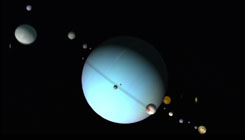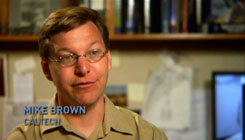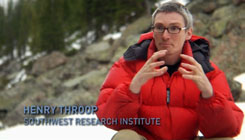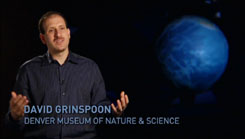This episode attempts to cover a lot of ground, hopping from planet to planet
to planet, and though it gets into a lot of good stuff, it ends up being
a bit more of a rush job than the episodes for Mars,
Jupiter, or
Saturn.
Pluto is up first, as we are teased with the question of why it is
no longer considered a planet. Some of its differences from the other eight planets
are highlighted as we dig into its composition and properties. We also learn why
we didn't yet have any really good photos of it by 2007.
The episode takes a twist as Mike Brown is revealed as
the man who discovered Eris in 2005. The similarities between
Eris and Pluto, plus discovery of many
more similar objects in the same space (Haumea, Makemake, 2007 OR10,
to name a few) caused the International Astronomical Union
to vote these objects into a new class called "Dwarf Planets".
Footage of this vote is here in the episode. Many of the details
of Eris are also explored here. Mention is also made of Ceres -
the largest asteroid in the "Maldek" belt
between Mars and Jupiter - which now also joins this
new crowd of dwarf planets.
Just over half-way through, we switch to the gas giant Uranus,
and as the details of its composition and properties come out,
we learn why it has the most serene weather of all of the gas giants
in our solar system. Both the original discovery of the planet,
and its faint rings (very beautifully rendered in CGI), are recounted here.
The episode is disappointingly light in talking about the planet's moons though,
skipping over the four to five big ones, and instead talking about the
little ones with crazy orbits. In particular, Michael Mischna suspects
that the moons Cupid and Belinda orbit so closely that they may one day collide.
Neptune gets a solid segment as its composition and properties,
which are quite different from Uranus, help us theorize as to why
it has the fastest winds in the solar system, and why these winds
wouldn't be much good at turning windmills. Also getting its due
in screentime is Neptune's moon Triton, as we learn why it is
one of the coldest places in the solar system, and how that defines
the conditions there.
At the very end, it is emphasized
that we know relatively little about these planets because we have not
yet explored them in any great depth with automated probes and spacecraft,
as Cassini continues to do for Saturn. Although Pluto may finally get its due
via the New Horizons spacecraft due to arrive in 2015, Ed Stone
adds his voice to those pushing for missions to Uranus and Neptune as well.
"We could, with Voyager, where we just had a brief fly-by
and we managed to collect a lot of discovery,
but in fact we need to get back to pursue those discoveries."
Chapter Breakdown:
- Introduction
- The Case for Pluto
- The Man Who Demoted Pluto
- Cool Blue Uranus
- Windswept Neptune
- Moons of Neptune
|
Participants include:
|

















